Kellogg MBA Students Choose Best 2019 Super Bowl Ads
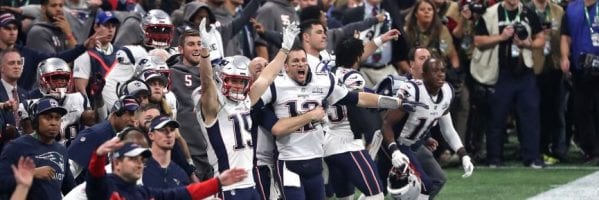
Aside from Tom Brady, Aaron Donald, and a shirtless Adam Levine, there’s no doubt that the Super Bowl commercials were the star of the night last Sunday.
The game, certainly, wasn’t the most thrilling. So the question is, what was the best ad of the 2019 Super Bowl? To get to the bottom of the question, a panel of Northwestern Kellogg MBA students got together to discuss each commercial. In the end, they looked for the ads that were the most and least effective at driving business and building their brands.
How Super Bowl Commercials Evaluation Works
First, before we dive into the best and worst ads, it’s important to know how the Kellogg MBAs made their evaluation. Working alongside two of the school’s most widely respected marketing professors—Time Calkins and Derek Rucker—the MBA panel applied the strategic ADPLAN framework.
A—Attention: Did the commercial engage the audience?
D—Distinction: Was the execution unique in delivery?
P—Positioning: Did the commercial represent the appropriate category and feature a strong benefit?
L—Linkage: Will the benefit and brand be remembered?
A—Amplification: Were viewers’ thoughts favorable?
N—Net Equity: Was the commercial consistent with the brand’s reputation and history?
From here, the MBA students came up with the final 2019 rankings.
Microsoft Super Bowl Commercial Wins
For the most effective ad, Microsoft took home the top prize. Their commercial spot was not only charming, but it stood out for its emotional tone and lack of clutter. The ad demonstrated Microsoft’s new adaptive controller and how it helps disabled kids play video games and form friendships. A clear benefit was apparent, showing how Microsoft technology makes the world a better place.
Amazon, Expensify, and Other Standouts
Other stand out advertisers for the Super Bowl included Amazon, Expensify, Washington Post, Pepsi, Bumble, and Google.
Bizarre Andy Warhol Burger King Commercial Flops
As for the least effective Super Bowl commercial, that honor went to Burger King. Their strange ad featured 1982 footage of Andy Warhol eating a Whopper, but it just came across as dull and uninteresting. Other advertising failures included the confusing Avocados From Mexico ad, Sprint’s flying horse disaster, the Turkish Airlines dark and scary spot, Mint Mobile’s unappealing chunky milk, and Simplesafe’s unbalanced ad. As for why each of these commercials failed, it always came back to a confusing message that didn’t deliver a clear benefit.
This article has been republished and edited from its original source, Clear Admit.
Forced Good Behavior Isn’t Good, According to Columbia – New York News
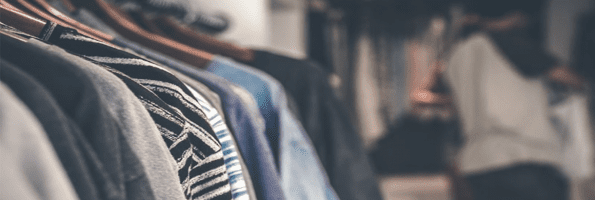
Let’s explore some of the most interesting stories that have emerged from New York City business schools this week.
Columbia Business School: Mandated Corporate Good Behavior Hurts Bottom Line & Reduces Efforts to “Do Good” – CBS Newsroom
New research from Columbia Business School professor Shivaram Rajgopal finds that mandatory Corporate Social Responsibility as a business practice is a “value-decreasing proposition for shareholders, and a disincentive for corporate good behavior.”
Raigopal writes, “Our findings prove that CSR is counterproductive when governments get involved. In developing an effective method for measuring CSR’s impact on business we were able to prove that CSR only has value if it is a voluntary activity. Shareholder value decreases as mandatory CSR increases. In fact, mandatory CSR is, in effect, nothing more than an inefficient backdoor tax on private sector.”
You can read more about Raigopal’s research here.
Introduction of Craigslist Increased Prostitution Across U.S. – Experience Stern
New research from NYU Stern School of Business and the University of Minnesota’s Carlson School of Management finds that “as Craigslist expanded across the United States, the free classifieds website also bolstered the sex industry,” which co-author Anindya Ghose, the Heinz Riehl Professor of Business at the Stern School, explains is “made up of both independent sex workers and workers operating under commercial vice groups.” In fact, Craigslist’s entry into a county increased prostitution cases—both “transactions by existing sex workers, as well as prompted recruitment and coercion of new ones”—by 17.58 percent.
The data was revealed in the recently-released study “The Digital Sin City: An Empirical Study of Craigslist’s Impact on Prostitution Trends”, which was “based on analysis of national panel data for 1,796 U.S. counties from 1999 to 2008.”
You can read more about the study here.
Lonely and Non-Empathetic People More Likely to Make Unethical Shopping Decisions – Binghamton SOM
New research from Binghamton SOM assistant professor of marketing Jenny Jiao finds that lonely consumers “very often behave immorally. And while these behaviors are often legal, they are unethical and cost retailers billions each year.”
She cites the common example of ‘wardrobing’ in which “someone may buy a big-screen TV for Super Bowl Sunday, only to return it on Monday; or they may buy a nice outfit for a night out, only to return it the next day.”
In Jiao’s paper, “Can Lonely People Behave Morally? The Joint Influence of Loneliness and Empathy on Moral Identity,” which was recently published in the Journal of Consumer Psychology, she was interested in how much of a factor loneliness played in this type of consumer behavior.
“We found that lonely people are capable of empathizing and making moral decisions, but they may not have the intention or motivation to. But when empathy levels increase, we don’t see much difference between lonely people and non-lonely people. Lonely people will be more likely to engage in moral behaviors and less likely to engage in immoral behaviors when they feel empathy.”
Read more about Jiao’s research here.
The History of the MIT Sloan Sports Analytics Conference
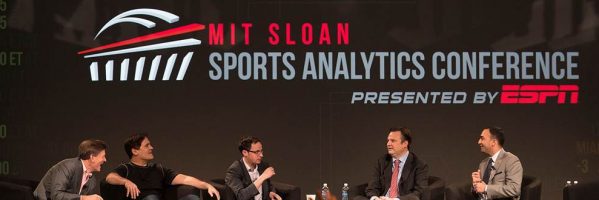
From February 23-24, one of the biggest events in the sports industry and analytics returns for its 12th annual iteration when the MIT Sloan Sports Analytics Conference comes to the Boston Convention and Exhibition Center.
This year, the conference promises to continue to break attendance records, as former President (and everyone’s favorite pickup hoops opponent) Barack Obama is among the scheduled speakers. Joining him will be luminaries of the sports industry such as Maverick Carter and Rob Manfred, and famed egghead and numbers-cruncher Nate Silver will also be along for the ride.
The conference is so large and popular, it is difficult to remember that what Fast Company has ranked as the 3rd Most Innovative Sports Company began as a humble, small-potatoes conference that took place in classrooms on the MIT campus. Let’s look back at the history of the SSAC as its number of attendees grew by more than two thousand percent, and it became a force to be reckoned in an industry given a projected value of $73.5 billion by Forbes.
The MIT Sloan Sports Analytics Conference Early Years
From our January announcement about this year’s event, Matthew Korman writes:
Co-founded by MIT Sloan School of Management MBA graduate Daryl Morey, the current general manager of the Houston Rockets, and Kraft Analytics Group CEO Jessica Gelman in 2006, the annual conference has transformed into one of the most formative sports business events in the world. Since its inception, the event has spawned and popularized numerous movements in the industry, including basketball’s strategic revolution (they call it MoreyBall for a reason).
From its first year in 2007 until 2009, the SSAC took place on MIT’s campus, and while attendance more than doubled during that period, it was still a comparatively low-key affair. Though 2008 brought a keynote speech by Boston Celtics CEO and co-owner Wycliffe Grousbeck, and 2009 saw the beginning of the ‘Featured Panel’ format, the conference was not yet the industry-driving behemoth that it is today.
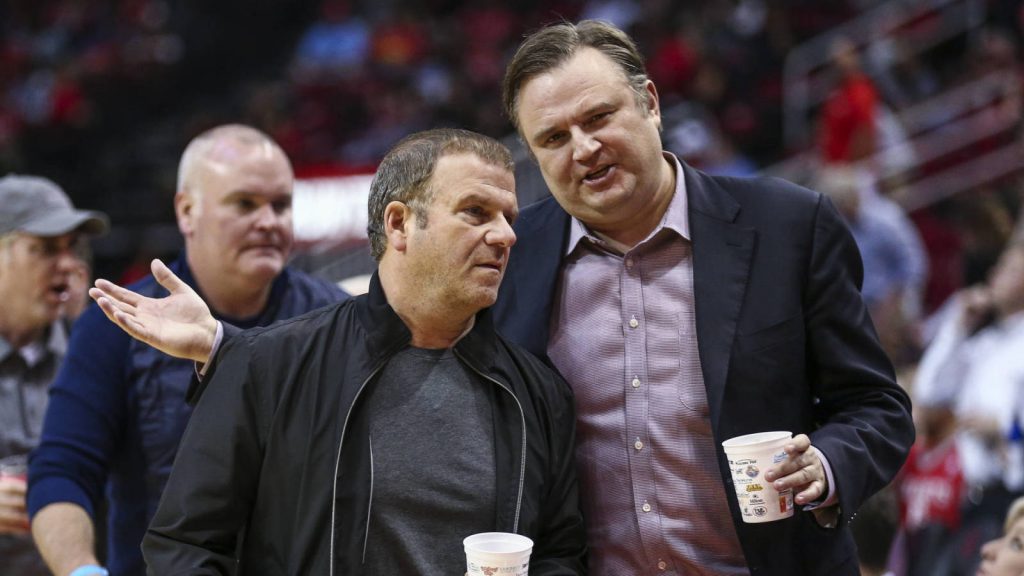
Houston Rockets owner Tilman Fertitta (left) and general manager Daryl Morey, MIT Sloan grad and co-founder of the MIT Sloan Sports Analytics Conference / Photo via USA Today
Growth Years
In 2010, the SSAC moved to larger digs (at its current home) due to interest and a surplus of programming. The conference’s main attraction was a panel on the limits of statistical analysis moderated by Moneyball author Michael Lewis, as well as the introduction of the research paper track to the conference’s programming. For this aspect, individuals and groups could submit original analysis of statistics-related issues to the organizing committee and vie for a cash prize.
But 2011 was the year that the conference really took aim for the heights of the sports industry: the research paper track was expanded, and a number of soon-to-be immensely popular segments were added to the traditional panel presentation structure. Firstly, Evolution of Sports (EOS) presentations were added, providing a sports industry analog to the ubiquitous TED Talks. In addition, it was the inaugural year for the First Pitch MBA Sports Business Case Competition, in which teams of MBA students from top-ranking programs were presented with a sports business situation and asked to provide a recommendation.
The event continued apace the next year, adding the Trade Show Business Competition, wherein start-ups explain their importance to the sports industry and the most convincing is awarded a cash prize, as well as the Alpha Awards, which recognize those that have altered the field of sports by utilizing analytics to defy conventional wisdom. The next few years of the SSAC saw unprecedented attendance at the conference as it became ever more notorious as a place where the heavy hitters of the sports industry, academia, and statistical analysis come together. The conference has even garnered some nicknames—“The Super Bowl of Analytics” and “Dork-A-Palooza.”
Then And Now
In 2016, conference chair Jessica Gelman noted in her opening remarks that “we had 175 folks at that first conference … this year we have more speakers than we had attendees [at that first conference].” Indeed, the most recent iterations of the SSAC have seen all segments of the conference grow, with an additional broadening of the scope of the conference. For example, in 2017, there were drone races, a live stream that reached an audience of 650,000 people, and a dedicated esports room. 2018 marks the first time that the conference is officially sponsored by ESPN. In final analysis, it seems the only place for the SSAC to go is up.
You can find more details about this year’s event here.
Amazon, Philly Win Super Bowl According to Northwestern Kellogg
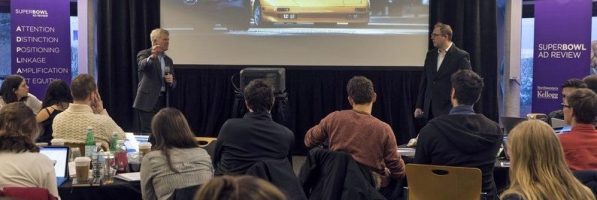
Philadelphia football fans took to the streets, toppling cars, scaling street lamps, and setting at least one fire to celebrate their beloved Eagles’ first-ever Super Bowl win, 41 to 33 against the New England Patriots. But according to MBA students at Northwestern’s Kellogg School of Management, e-commerce giant Amazon was the victor in terms of best ads of the night.
On Sunday, as the game got underway in minus-2-degree Fahrenheit Minneapolis, approximately 50 Kellogg students teamed up with marketing professors Tim Calkins and Derek Rucker to determine the night’s winners and losers in the battle of the brands. Advertisers spend more than $2 billion each year and roll out highly anticipated Super Bowl commercial spots in an effort to imprint their brands in the minds of millions of spectators—some wowing and others bombing in the process.
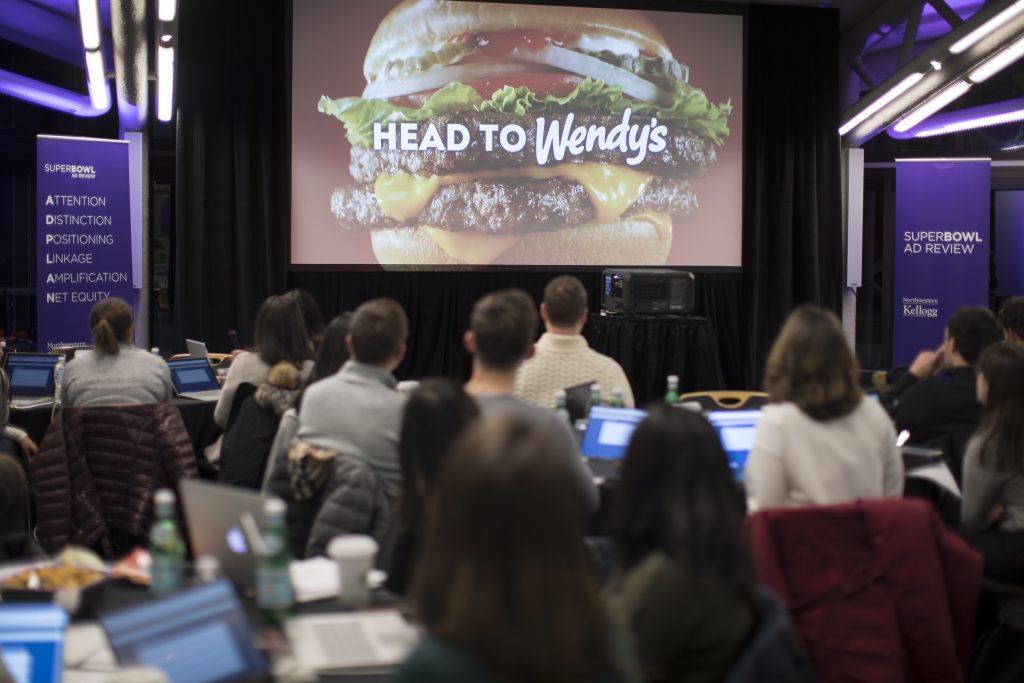
Kellogg students watch commercials during the Super Bowl at the Allen Center Atrium in Evanston, Illinois, February 4, 2018. Photo by Jim Young for Kellogg
Armchair spectators around the world pick their own winners and losers among the ads, but for the 14th year running, Kellogg students applied a unique framework for evaluating an ad’s brand-building potential as part of last night’s 2018 Kellogg School Super Bowl Ad Review. Using the ADPLAN framework to evaluate each ad according to six critical criteria—Attention, Distinction, Positioning, Linkage, Amplifications and Net Equity—the Kellogg students determined the winner of the night to be Amazon with its “Alexa Loses Her Voice” commercial spot. Also scoring highly were Mountain Dew, Doritos, Tide, Avocados from Mexico, and Wendy’s.
Joining the Pats in defeat, according to the Kellogg review, were Squarespace and T-Mobile, which each received “F” grades for least effective advertising during the game.
“Amazon used a cast of celebrities that focused us on the brand, reinforced the equity in Alexa, and ultimately was fun to discuss and share with those around you,” Professor Rucker said in a statement. The Amazon ad included appearances by Cardi B, Rebel Wilson, and Amazon CEO Jeff Bezos. “However, Squarespace and T-Mobile both missed the mark with questionable positioning and unclear calls to action,” continued Rucker.
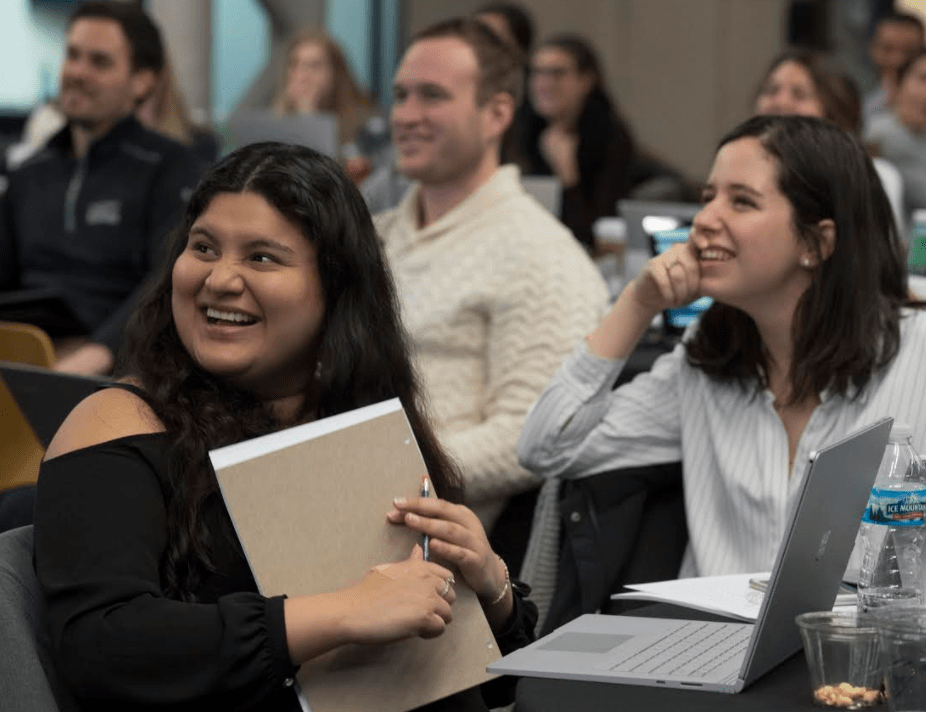
Kellogg students analyzing Super Bowl ads in real time. Photo by Jim Young for Kellogg
Professor Calkins called attention to two trends that emerged across the big game’s ads—a competitive angle and philanthropy. “As competitive as the game was, the category wars were equally competitive,” Calkins said in a statement. “For example, there was hard hitting competition in the wireless wars with some brands calling one another out,” he noted. In addition to poorly performing T-Mobile, wireless advertisers included Sprint and Verizon, which the Kellogg student review team each awarded “B” grades.
“Many brands tried to appeal to viewers through philanthropic causes, including Toyota, Ram, and Hyundai,” Calkins added. Ram, for its part, sought to sell its trucks using images of people helping others with a sermon given by Dr. Martin Luther King, Jr. as the voice over. The ad concluded with the phrase “Built to Serve” flashed on the screen alongside a Ram logo. Unfortunately for Ram, the social media backlash was fast and furious.
“A Martin Luther King Jr speech to sell @Dodge Ram trucks? Totally offensive #mlk,” wrote one user on Twitter.
Several other tweets expressed similar sentiments:
There was audible painful groaning at the Super Bowl party I’m at as everyone realized Dodge Ram was trying to profit off of an MLK speech
— Hunter Walker (@hunterw) February 5, 2018
Not sure MLK’s dream was to drive a Dodge Ram.
— ItsTheReal (@itsthereal) February 5, 2018
“I have been to the mountaintop. And I got there in a Ram truck.” – MLK
— SportsPickle (@sportspickle) February 5, 2018
The Kellogg student team gave the Ram commercial a “C” grade overall, but Calkins had more to say in an interview with the New York Times. “It’s the wrong mistake to make given everything that’s going on in the U.S. right now,” he told the Times. “There’s so much emotion right now around race in this country that this was a high-risk move, and clearly it’s not going over very well,” he continued.
“I think it was well intentioned, but they’re going to have a lot of explaining to do,” Calkins continued. “They did not release this ahead of time, so they went for the surprise. They got that, but at the same time they now have a big problem with feedback and people being upset.”
Though many on Twitter directed their ire toward Dodge—the Detroit-based car manufacturer founded by two brothers of that name in the early 1900s—the Ram Truck brand was officially separated from the Dodge car brand in 2009 as part of an acquisition by Italian automaker Fiat S.p.A. Its successor, Fiat Chrysler Automobiles, is the current owner of the Ram Tuck brand.
Perhaps some of the confusion around brand will be a boon to Ram’s owner as it attempts to recover from its Super Bowl fumble. As for whether ad champion Amazon will look favorably on football champion Philadelphia as a spot for its future HQ2—another topic of speculation on social media last night—only time will tell. What we do know is that the students at Kellogg will carry lessons learned from advertising’s biggest night along with them into their future careers in marketing.
For the full 2018 Kellogg School Super Bowl Ad Review results, click here.
To learn more about the Kellogg School Super Bowl Advertising Review, click here.
This article was republished with permissions from our sister site, Clear Admit.
Philly Schools React to Eagles Super Bowl Triumph
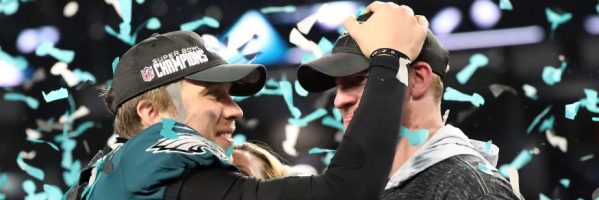
Philadelphia Eagles fans around the world rejoiced last night, taking home the first Super Bowl victory in the history of the organization. A handful of Philly business schools also joined in the jubilation after the upset of the New England Patriots, sharing a round of joyous reactions.
Drexel University and the LeBow College of Business was among the first to share their reaction to the Eagles victory, posting a celebratory video from University president John Fry.
On behalf of #Drexel Dragons everywhere, congratulations to our Super Bowl Champion Philadelphia @Eagles! #SBLII #SB52 #SuperBowlChampions #flyeaglesfly pic.twitter.com/VLtQkxezgn
— Drexel University (@DrexelUniv) February 5, 2018
Temple University and the Fox School of Business were a bit less formal in their congratulatory Eagles reaction, posting the following.
“True leadership is about action.” #FlyEaglesFly https://t.co/NSip55sAE6
— Fox School (@foxschool) February 5, 2018
Hey @Eagles,
That was fly. #FlyEaglesFly— Temple University (@TempleUniv) February 5, 2018
The West Chester Philadelphia campus took things a bit further, lighting up its buildings in heavy Eagles green.
WCU’s Philadelphia campus showing just a tad 😉 of Philadelphia @Eagles pride #flyeaglesfly #superbowlchamps #ramsup #wcuphilly pic.twitter.com/QsXFeio5Gr
— West Chester U (@WCUofPA) February 5, 2018
Villanova Business went a bit of a different direction, with students Michelle Maduras (’19 VSB) and Kriya Amin (’19 VSB) review the night’s ads in a live feed. Some of their favorites from Sunday night came from Mountain Dew, Doritos, and, of course, the New York Giants’ Dirty Dancing inspired tribute.
That's all from us! Thanks for following our SuperBowl takeover, and congratulations to the @Eagles, #FlyEagelsFly!!! pic.twitter.com/54q7KeFNee
— Villanova Business (@VU_Business) February 5, 2018
Out of Chicago, experts from the Northwestern Kellogg School of Management revealed their thoughts on the Super Bowl 52 ads, which you can check out over at Clear Admit.
Gupta MBA Earns Spot At The Super Bowl

Thanks to her strong business education from the University of Dallas – Satish and Yasmin Gupta College of Business , MBA graduate Kelly Jones was given the once-in-a-lifetime opportunity to attend this years’ biggest sporting event: the Super Bowl.
